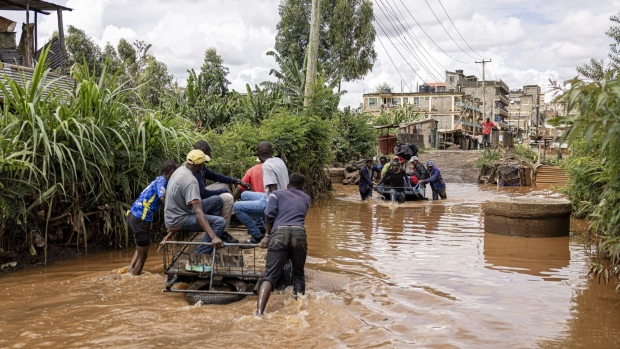May 3, 2024
Drought to Deluge: Eastern Africa Bears Brunt of Climate Change
, Bloomberg News

(Bloomberg) -- East Africa is bracing for more floods, as torrential rain after years of drought deliver a reminder of the threat created by climate change.
Tropical Storm Hidaya is expected to make landfall this weekend, worsening the deluge that has already killed hundreds of people and swept away crops and livestock.
Hidaya has formed off the coast of Mozambique in the Indian Ocean, according to the US Joint Typhoon Warning Center. While the system will probably weaken as it approaches the coast, it could dump even more rain once it reaches land.
The death toll from the deluge already stands at 210 in Kenya, 155 in Tanzania and 29 fatalities in Burundi.
Read more: How Scientists Link Climate Change to Extreme Weather: QuickTake
“The current unprecedented crisis of floods that our country is experiencing, as well as the recent devastating drought our country faced — the worst in 40 years, after five consecutive failed rains — is a direct consequence of our failure to protect our environment,” President William Ruto said Friday in a televised speech. “Our country will remain in this cyclical crisis until we confront the existential threat of climate change.”
Africa has suffered a heavy toll from climate change, despite having contributed relatively little of the greenhouse gas emissions that are warming the planet. While it takes time to evaluate the impact of climate change on heavier rainfall, scientists have found that warmer air holds more water.
A study on the rain that inundated Dubai earlier this year found global warming made it as much as 40% more intense. The same research group also found that climate change exacerbated deadly flooding that hit West Africa in 2022.
That year, East Africa suffered its worst drought in four decades, driving food-price inflation and fanning a cost-of-living crisis that provoked protests in Kenya and widespread hardship in a region already battling challenges including conflict and extreme poverty.
“Climate change is exacerbating these challenges with significant impact on livelihoods and food availability,” according to the Food Security and Nutrition Working Group, a regional platform co-chaired by the Kenya-based IGAD Climate Prediction and Applications Centre and the Food and Agriculture Organization of the United Nations.
Kenya usually receives seasonal rains March to May, but the downpours have been severe this year, worsened by the El Niño weather phenomenon. These rains will persist, increasing in both duration and intensity, for the rest of of this month and could extend into June, Ruto said.
“No corner of our country has been spared from this havoc,” he said. “Sadly, we have not seen the last of this perilous period, as the situation is expected to escalate.”
Even after the flooding abates, East Africans will continue to feel the effects through higher food prices. Wide swathes of croplands have been destroyed and livestock killed according to the FAO. The rains have also damaged roads and bridges, crimping the movement of people, fuel and food, which will add further to costs.
Kenyan inflation cooled to 5% year-on-year in April compared with 5.7% in the prior month as energy and food prices eased, but the flooding puts that at risk.
“Although a bumper harvest season has helped replenish food stocks in Kenya, the recent downpours might cause a spike in domestic food prices,” Oxford Economics’ Shani Smit-Lengton wrote in a note to clients. “Moreover, since Kenya is in its main planting season — mid-March to end-May — the heavy rainfall could wash away seeds and damage agricultural land.”
FAO data shows that 35 million people are in need of food assistance across the region, worsening food insecurity.
At the same time, malaria and other water-born diseases will likely increase. Africa already shoulders the heaviest burden of the disease — accounting for 95% of malaria deaths reported at 608,000 in 2022, according to the World Health Organization.
There is a solitary silver lining: Rising water levels are expected to bolster the generation of cheaper hydro-power and recharge groundwater reserves for geothermal power production.
For the first time in its history, Tanzania has recorded an energy surplus, helped by more generation from hydro-power plants, Energy Minister Doto Biteko told Parliament.
--With assistance from Fumbuka Ng'wanakilala and Sharon Chen.
(Updates with Kenyan president’s comments from fifth paragraph.)
©2024 Bloomberg L.P.


